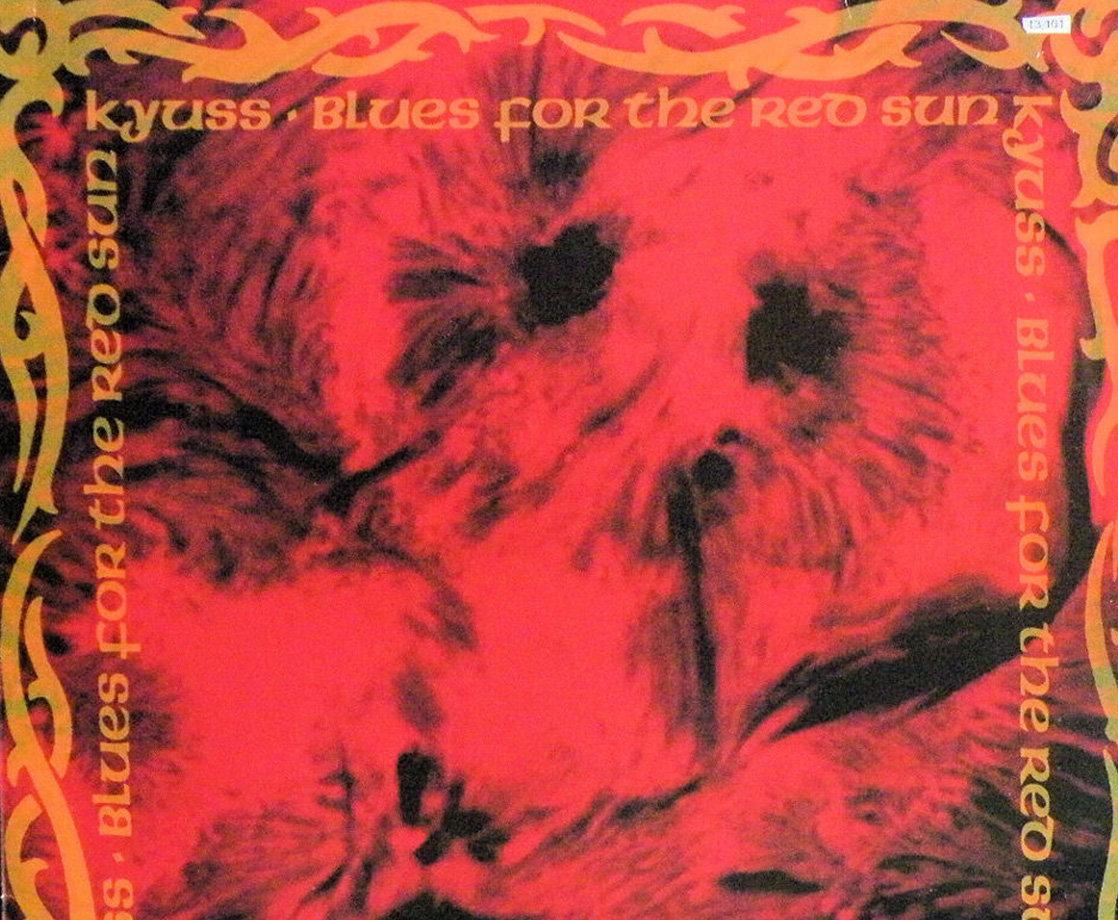Brian Eno famously quipped that although the Velvet Underground’s first album only sold 30,000 copies, “everyone who bought one of those 30,000 copies started a band.” It was an overstatement, but when Eno said it 1982, he was talking about the relatively recent outbreaks of punk, new wave, no wave, and college rock, all genres that included bands who cribbed something from Lou Reed & Co. In that landscape, Eno made sense of a niche interest-turned-phenomenon, tracing a ‘60s band all the way to the dawn of indie rock.
In January 1994, Billboard’s Chris Morris wrote something similar about Kyuss and their second album, Blues for the Red Sun. “Kyuss is the band with the biggest awareness level for a group whose last record sold 40,000,” he proposed, citing the band’s recent tours with Danzig, White Zombie, Faith No More, and Metallica, as well as all of the radio and Headbangers Ball airtime their singles had gotten. That’s only one-half of the Velvet Underground quote though — Morris said nothing explicitly about the band’s influence.
18 months is usually too short of a window to gauge an album’s impact, but Morris added something in the same article that inadvertently illustrates the vast wake Kyuss plowed with that album. Offhandedly, he calls the band’s sound “tough-to-pigeonhole.” Viewed today, that’s an almost laughable statement. Kyuss is stoner metal like water is wet, like fire is hot; they embody the genre in an almost elemental sense. Shocking as it is to hear though, that catch-all term for the more psychedelic, hard rock-tinged cousin to sludge and doom metal didn’t really exist in 1994. Stoner metal’s now one of the most popular heavy music subgenres worldwide, with bands like Red Fang, Orange Goblin, and The Sword now able to tour their dank riffs internationally. But from which bong did this wellspring bubble? Most signs point towards Kyuss’ Blues for the Red Sun, which turns 25 today.
Defined by meaty riffs, basslines that undulate like desert dunes, abrupt-but-cathartic tempo changes, and singer John Garcia’s of-the-moment yarl, the album was a vast improvement on the band’s rawer, faster, and boozier 1991 debut, Wretch. Guitar wunderkind Josh Homme, who turned 19 just a month before Blues for the Red Sun’s release, began crafting a signature style here, downtuning his guitar and plugging it into bass and guitar amps at the same time to achieve maximum chug. The sound was brawny and propulsive, yes, but also psychedelic and swirling. I could go on for another couple of paragraphs here, but no description I can offer would be better than the tagline used by Dali Records when marketing the album: "A fresh bong load of potent, sticky, and hairy musical salvation.”
Garcia also nailed it when summing up his band’s sound to Billboard: “Black Sabbath was heavy but it sounded indoors. Kyuss sounds like it’s outdoors.” That’s not just an apt metaphor — at this point in their career, Kyuss were largely a literal outdoor band. The Palm Desert scene from which they came was built around “generator parties” or “dust festivals,” wherein bands would lug their gear out to remote locations in the desert, plug into gigantic generators, and soundtrack all-night, drug-fueled parties. This invention was initially out of necessity, as the Palm Desert/Springs area housed few clubs willing to host hard rock bands, but it quickly became an attraction unto itself. (These events’ lawlessness eventually got out of control, but recently, Kyuss drummer Brant Bjork has started hosting a more legit annual festival called Desert Generator.) One such generator party was depicted in the video for Blues for the Red Sun album cut “Green Machine,” which made the MTV rounds in the early ‘90s.
A key player in Kyuss’ history was BftRS producer Chris Goss, frontman of Masters of Reality, a progressive hard rock band named after a Sabbath album. Although they originally hailed from Syracuse, MoR became associated with the Palm Desert scene due to sound and, after they moved to LA on the heels of a new record contract in 1988, proximity. According to Goss, he saw Kyuss play an LA show that ended in a brawl in 1990, and was so hooked that he not only went to Palm Desert to work with them, but soon moved there himself.
Disgusted by the prevailing hair metal trend he’d seen in LA, Goss thought to himself after seeing Kyuss, “I'm not letting any shithead metal producer touch this band and ruin it." The band struck a chord with his Sabbath-obsessed id, but he also heard something new and exciting that they were tapping into: “I walked up to Josh afterwards and I said, ‘‘Are you a Sabbath fan?' And he said, ‘‘No, I've never really listened to Sabbath.' I knew we were on to something. This was coming from them."
Indeed, Homme did not begin life as a fan of Sabbath, the band that may have actually invented stoner metal in 1971 on Master of Reality intro track “Sweet Leaf.” Homme was more into punk as a kid, and his main touchstone for Kyuss was the legendarily sludgy Side B of Black Flag’s My War: “I loved Black Flag’s Jealous Again and Damaged, but it was My War that really summarized Kyuss’ approach to punk.”
Sabbath wasn’t the only band that laid the bedrock upon which Kyuss built stoner metal. Due to a young Kurt Cobain’s fondness for them, Washington State’s Melvins are most frequently credited as grunge forebears, but even before 1994’s Stoner Witch, the sludgy riffs of their late ‘80s material predicted much of what was to come in cannabinol-fueled strains of metal. The early ‘90s incarnation of Maryland’s The Obsessed, featuring doom icon Scott Weinrich and future Kyuss bassist Scott Reeder, played doomy metal similarly fueled by punk rock, but with more of a leather-clad biker vibe.
But what Kyuss had that their predecessors didn’t, aside from a more crystallized vision of genre alchemy, was reach. None of the aforementioned bands, save for the more straightforward and less weedy ‘80s incarnation of Sabbath, received much attention from mainstream media, and none of them toured with Metallica. In Chris Morris’ words, Kyuss “occupie[d] unexplored terrain between conventional metal and… alternative acts like Soundgarden” to the degree that they had crossover appeal between metalheads and grunge bandwagoners. In an era when Headbangers Ball had metal front-and-center alongside Michael Jackson, and grunge was the nation’s fad du jour, Kyuss came out seeming almost scientifically created by advertisers looking to appeal to target demographics. The key was, they weren’t, and they were so off the beaten path in their own little corner of Southern California that authenticity wasn’t even a question.
I’d be remiss if I didn’t mention some of Blues for the Red Sun’s main competition for the title of Most Influential Stoner Metal Band. Sleep, a much slower, doomier band from San Jose, released their monumental debut album, Holy Mountain, in November 1992, just five months after BftRS. New Jersey’s more rock-oriented Monster Magnet dropped their debut, Spine of God, four months earlier. Orange County’s Fu Manchu, whose 1994 debut would be produced by Brant Bjork, were putting out stonery seven inches throughout the early ‘90s.
For a number of reasons, most related again to lack of attention from the media (Spine of God was named one of SPIN’s “10 Best Albums of the Year You Didn’t Hear”), none of these bands threatened Kyuss’ reign. “No band had a greater influence or impact on the stoner rock movement than Kyuss,” wrote Daniel Bukszpan in his 2003 tome The Encyclopedia of Heavy Metal, calling BftRS the genre’s “primary source material.”
Blues for the Red Sky was mostly comprised of short songs with creative, if not particularly complex, structures. For that reason, aspects of it have been easily replicated by the pantheon of stoner bands that followed. Kyuss’ 1994 follow-up, Welcome to Sky Valley, is almost assuredly a better album, but divided into four nearly 20-minute-long segments that flowed together as suites, its ambition and the band’s progression as musicians ensured that imitation would be a much more difficult feat. To return to the Velvet Underground comparison, ‘80s dream pop bands made careers out of recreating “Sunday Morning,” not the 17-minute-long “Sister Ray.”
Josh Homme would go on to find much greater success in Queens of the Stone Age, a rock band only tangentially related to metal, while the rest of Kyuss mutated and fused into other bands throughout Southern California (especially John Garcia, who’s worked with something like 15 bands over the course of his career). Kyuss broke up in 1996, leaving the stoner metal torch to be carried on by other groups, and legions of them rose to the occasion.
Why did so many ears perk up in the metal, punk, and hard rock worlds when Blues for the Red Sun first surfaced? Because they were already filled with pot smokers, and it was almost as if stoners everywhere were waiting for something to rise up and usurp Dark Side of the Moon and “Smoke on the Water” as angstier go-to smoking jams. Lord knows the ‘80s didn’t supply many of those. Better albums followed, and some (like Sleep’s Dopesmoker) are more tailor-made for marijuana consumption, but most of them wouldn’t be here were it not for Blues for the Red Sun.
Follow Pat Lyons on Twitter











